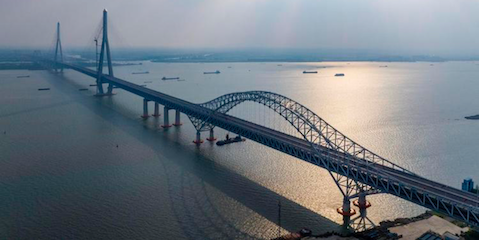
Changzhou-Taizhou Yangtze River Bridge. A monumental cable-stayed road bridge located in eastern China, connecting Changzhou in Jiangsu Province’s south bank and Taizhou on the north bank of the Yangtze River.
This infrastructure project is among the most significant contemporary feats of civil engineering in China, combining functionality, sustainability, and design innovation. The bridge, part of the G40 Shanghai–Xi’an Expressway, was opened to the public in 2022 and spans a total length of approximately 11.07 kilometers, with a main span of 1,176 meters—ranking it among the longest cable-stayed bridges in the world. It plays a pivotal role in enhancing regional connectivity, economic integration, and transportation logistics across the Yangtze River Delta.
Constructed at a cost exceeding 11 billion yuan (approx. $1.6 billion USD), the Changzhou-Taizhou Yangtze River Bridge was designed to support a six-lane expressway with a speed limit of 100 km/h. The project showcases the synergy between urban development, infrastructure modernization, and green transportation. The bridge’s architecture integrates seismic resistance, typhoon mitigation, and high-traffic resilience—ensuring longevity and safety for future generations.
As part of China’s broader Belt and Road Initiative and its ongoing infrastructure-driven development model, the Changzhou-Taizhou Yangtze River Bridge is also emblematic of the country’s ambition to pioneer globally recognized, large-scale engineering projects. It facilitates more efficient commuting and freight transportation, especially between the industrial hubs of Changzhou, known for its advanced manufacturing, and Taizhou, noted for pharmaceutical and mechanical industries.
The project has garnered international attention for its technical prowess and logistical execution, contributing to a growing corpus of case studies in structural engineering, transportation planning, and sustainable infrastructure.
The importance of the Changzhou-Taizhou Yangtze River Bridge extends beyond transportation. The bridge facilitates the efficient movement of goods and people across the Yangtze River Delta, one of China’s most dynamic economic regions. By easing traffic congestion and reducing dependence on ferries or longer detour routes, the bridge contributes to the reduction of carbon emissions and promotes sustainable urban development.
In addition to its functional significance, the bridge is a marvel of design and environmental stewardship. Engineers used cutting-edge materials and construction techniques to minimize ecological disruption. The bridge’s aesthetic appeal, featuring elegant symmetry and illuminated spans, has also made it a popular subject for photographers and engineers alike.
While not yet a household name globally, the Changzhou-Taizhou Yangtze River Bridge is increasingly recognized as a case study in modern civil engineering. As such, it is frequently referenced in academic literature and professional conferences. It represents the convergence of architecture, mobility, and regional planning — a testament to 21st-century infrastructure innovation.